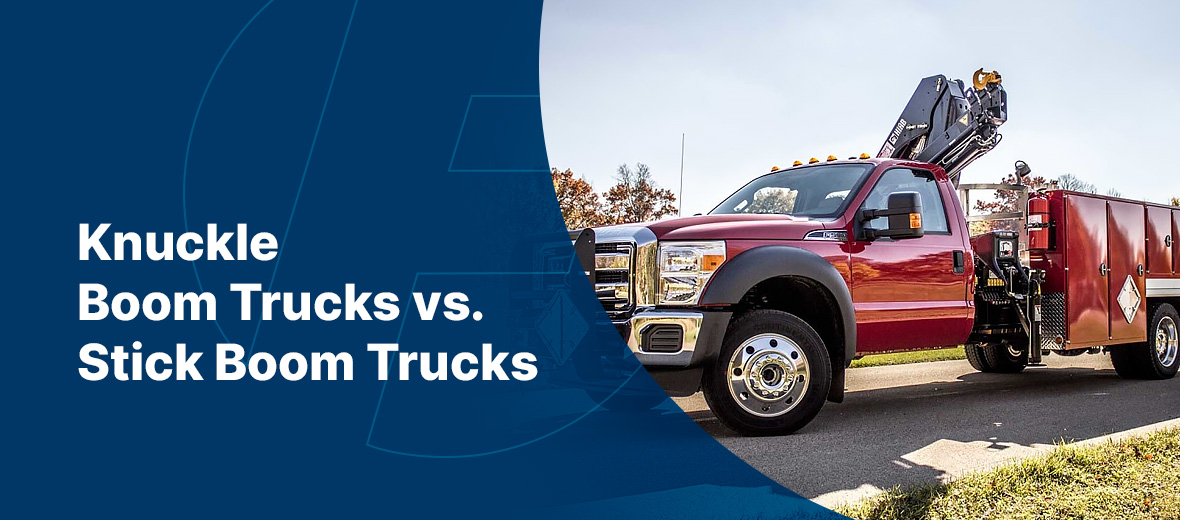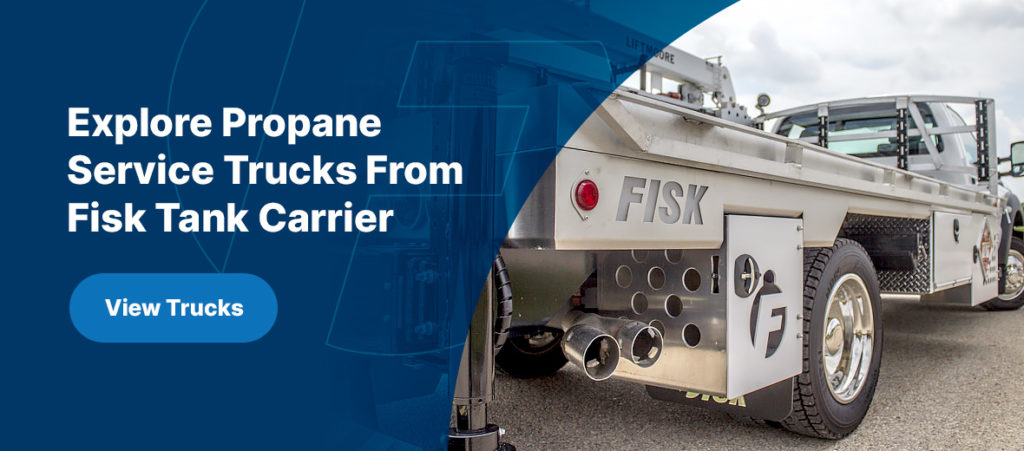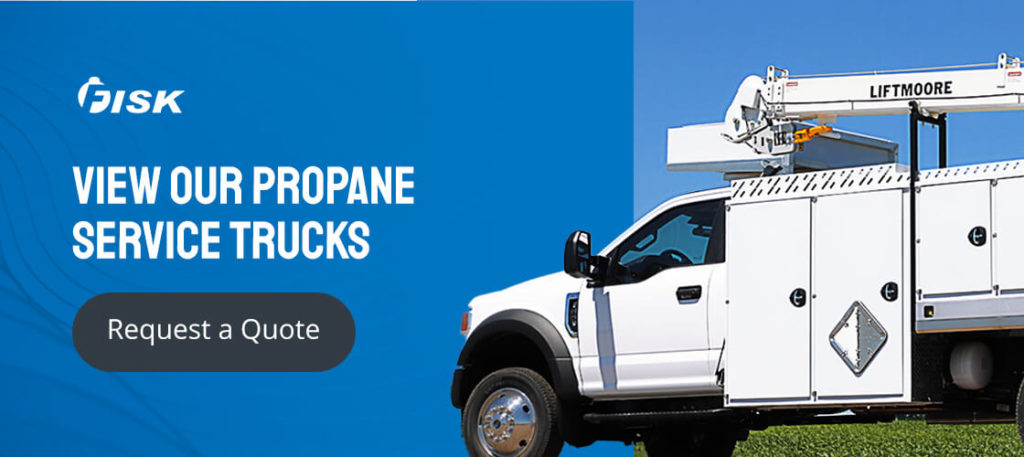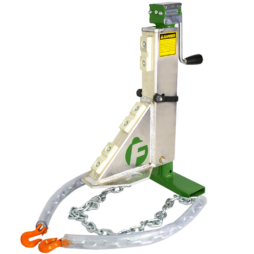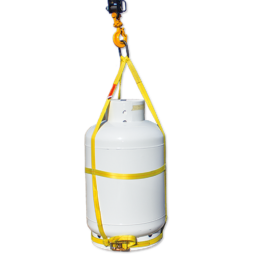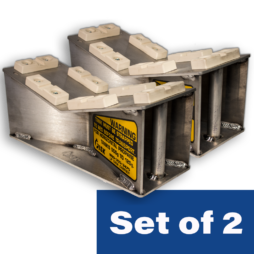Table of Contents
1. Understanding Boom Trucks
2. Knuckle Boom Trucks
3. Stick Boom Trucks
4. Factors To Consider Before Buying
From roofing to construction, many industries utilize boom trucks for various applications. When choosing the right type of boom truck for your business’s needs, it is essential to differentiate between the two types.
Knuckle boom trucks and stick boom trucks have different purposes and unique capabilities. Before making a decision, consider what kind of aerial lift equipment you’ll need for the jobs you do now and the ones you want to do in the future.
Read on to learn more about the different types of boom lifts and how they compare to one another.
Understanding Boom Trucks
A boom truck is a type of mobile crane with three main features:
- Boom: A boom refers to the extending arm equipment that handles and lifts materials.
- Flatbed: Boom trucks have a flatbed behind the truck’s cabin. As opposed to a crane, the boom is mounted to the bed of these commercial trucks.
- Cabin: The driver’s cabin, where operators drive the truck, typically contains the boom controllers.
Knuckle Boom Trucks vs. Stick Boom Trucks
When a business considers adding a boom truck to their equipment lineup, choosing the right option for their specific applications is essential.
Knuckle boom trucks are more suitable for jobs that require reaching challenging workspaces, while stick boom trucks are ideal for reaching high elevations and holding loads in place. Consider the following overviews to better understand which type of boom truck is right for your business.
Knuckle Boom Trucks Overview
When it comes to knuckle boom trucks, consider the following information about their operation and uses.
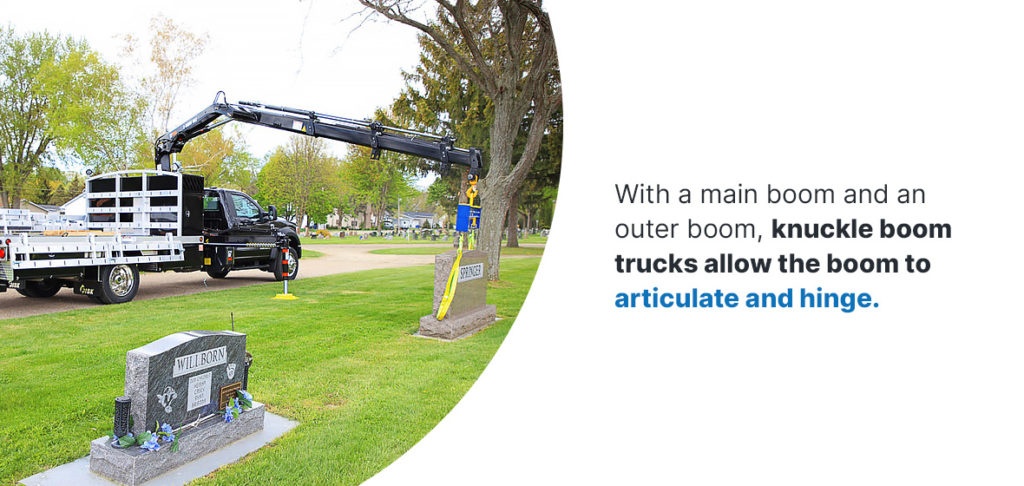
What Is a Knuckle Boom Truck?
Knuckle boom trucks are a highly versatile type of compact work vehicle. A knuckle boom crane is also known as the following:
- Articulating boom
- Loader boom
- Picker boom
- Up-and-over boom
Unlike traditional straight booms, this type of vehicle has two booms. With a main boom and an outer boom, knuckle boom trucks allow the boom to articulate and hinge. The section of the equipment where it bends is the joint or knuckle, giving it its name.
Thanks to its capability to bend, the crane on this type of truck can access tough-to-reach work areas, giving it a unique advantage over other cranes. With a knuckle boom, you can perform critical jobs for various industries that require lifting, loading and unloading.
There are a variety of different attachments available for these booms, making them highly versatile. This kind of boom truck is typically lighter and more compact than a conventional crane. Since there is often additional space for carrying loads in the truck bed, a knuckle boom truck is a handy piece of equipment for many different types of jobs.
How Does a Knuckle Boom Truck Work?
Operators can control knuckle boom trucks in a few different ways, including lower control stations and a radio remote control. Both have either manual or electric controls. Greater visibility is one of the greatest advantages of operating from fixed controls. The worker can safely do their job from a turret or enclosed cabin.
Along with its easy operation, an articulated boom truck can perform a wide range of jobs by utilizing various attachments, including the following:
- Grapples
- Grabs
- Forks
- Buckets
- Rotators
- Augers
All knuckle boom truck operators must comply with the Occupational Safety and Health Administration (OSHA) standards for power-operated equipment and attachments.
What Is a Knuckle Boom Truck Used For?
Thanks to its design, this type of boom truck is ideal for moving heavy loads from one point to another on a job site. Since it is a compact piece of equipment, it is often a good choice for confined or narrow spaces that are difficult to reach with traditional cranes. The following industries often utilize knuckle boom trucks for their applications:
- Oil and gas: Knuckle booms are useful for lifting and moving large tanks and other oilfield equipment.
- Construction: Articulated booms are useful for hauling materials across job sites.
- Forestry: Knuckle boom cranes make accessing hard-to-reach branches and towering trees easier.
- Roofing: Lifting and lowering roofing materials is easy with this type of work truck.
- Utilities: Thanks to its transportability, a knuckle boom truck is a great option for tending to electric lines and other high-up utilities.
Pros of Using a Knuckle Boom Truck
Consider the following benefits of an articulated boom truck:
- Easy travel: A knuckle boom truck’s compact size allows for easy travel, especially compared to other heavy equipment that requires special hauling to transport it from one job site to the next.
- Diverse attachments: Thanks to the many attachments for the end of this type of truck, operators can diversify the kinds of jobs they perform with this equipment.
- Horizontal lifting: The knuckles on an articulated boom truck allow for lifting in both vertical and horizontal positions, minimizing the space needed for the job.
- Loading and unloading: Since a knuckle boom truck requires less vertical clearance than a traditional boom crane, loading and unloading are much easier.
- Maneuverability: An articulated boom truck fits onto a truck, making it more compact than other heavy equipment and allowing it to easily access narrow and confined workspaces.
Cons of Using a Knuckle Boom Truck
In addition to their many benefits, using a knuckle boom truck has a few disadvantages to consider. One con of using articulated boom lifts is their high power demand — a knuckle boom truck’s multiple parts require more energy than trucks with a traditional straight boom.
In addition to the power demand, this type of boom truck has higher maintenance needs. Because they utilize more moving parts, it is essential to complete maintenance more often on a knuckle boom truck than on a stick boom truck.
Stick Boom Trucks Overview
Stick boom trucks have a few key distinctions. Learn more about this type of boom truck and its operation.
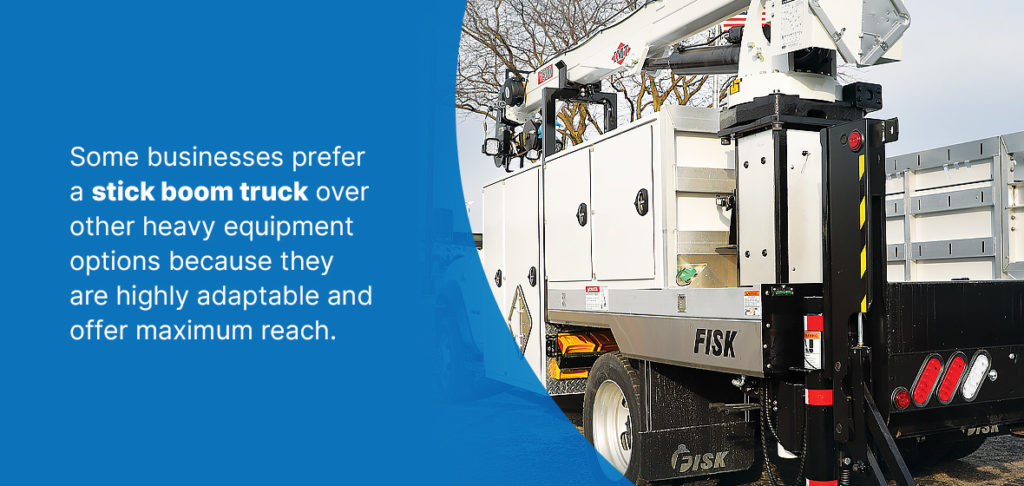
What Is a Stick Boom Truck?
Because of the way its arm extends, the stick boom on a truck also goes by the following names:
- Telescopic boom
- Straight boom
- Stiff boom
A hydraulic cylinder allows the boom to reach various lengths. While knuckle booms can be fitted to a truck or trailer bed, this type of boom truck typically has the arm permanently affixed to the truck.
Some businesses prefer a stick boom truck over other heavy equipment options because they are highly adaptable and offer maximum reach. With this type of truck, operators can lift heavy loads in a vertical direction.
How Does a Stick Boom Truck Work?
A straight boom extends and contracts in a straight line, similar to how a telescope lengthens. The arm attaches to a rotating turntable, allowing it to extend straight upward or at an angle. Since a stick boom’s arm is not articulated like a knuckle boom’s, these trucks are more limited in terms of the angles and directions they can reach.
While a stick boom truck crane is not as suitable for challenging work areas, they have considerable reach and can often access higher heights than other types of heavy equipment.
What Is a Stick Boom Truck Used For?
Several industries utilize stick boom trucks, including:
- Construction: The construction industry uses this type of boom truck for hoisting materials and transporting loads to various heights.
- Telecommunications: The telecommunications industry uses stick boom trucks for various applications, from accessing cell phone towers to laying concrete foundations.
- Roofing: A telescopic boom truck can be useful in lifting roofing materials to workers and increasing job productivity.
- Transportation: The transportation industry utilizes this type of boom truck for various applications, including carrying materials for building bridges and hoisting highway signs into place.
Pros of Using a Stick Boom Truck
Utilizing a stick boom truck can be beneficial in a wide range of applications. Some of the key advantages of this equipment include the following:
- Maximum reach: Straight boom trucks can be very advantageous for businesses that perform functions at high heights. One of the greatest pros of using a telescopic boom truck is its long reach. Operators can adjust the height according to their needs and can often access heights beyond other types of heavy equipment.
- Transporting loads with precision: A stick boom truck’s design allows operators to move loads with extreme precision and stability. Many of these types of trucks are equipped with stabilizer legs to improve safety and keep the vehicle grounded.
- Elevating heavy loads: Stick boom trucks can hoist heavy loads to high elevations. While other pieces of heavy equipment are confined to load capacity or reach, these trucks can deliver on both.
Cons of Using a Stick Boom Truck
Although these trucks offer many advantages, they also come with a few cons. For example, an arm that can only extend in a straight line makes a stick boom truck considerably less maneuverable than a knuckle boom truck.
Another con of these trucks is that they are not suitable for confined or narrow workspaces. Unlike hinged booms that can meet many different angles, it’s more challenging to access hard-to-reach areas over obstacles with straight booms.
Factors to Consider Before Buying a Knuckle Boom Truck or Stick Boom Truck
Before choosing a boom truck for your business, it is beneficial to consider the following factors:
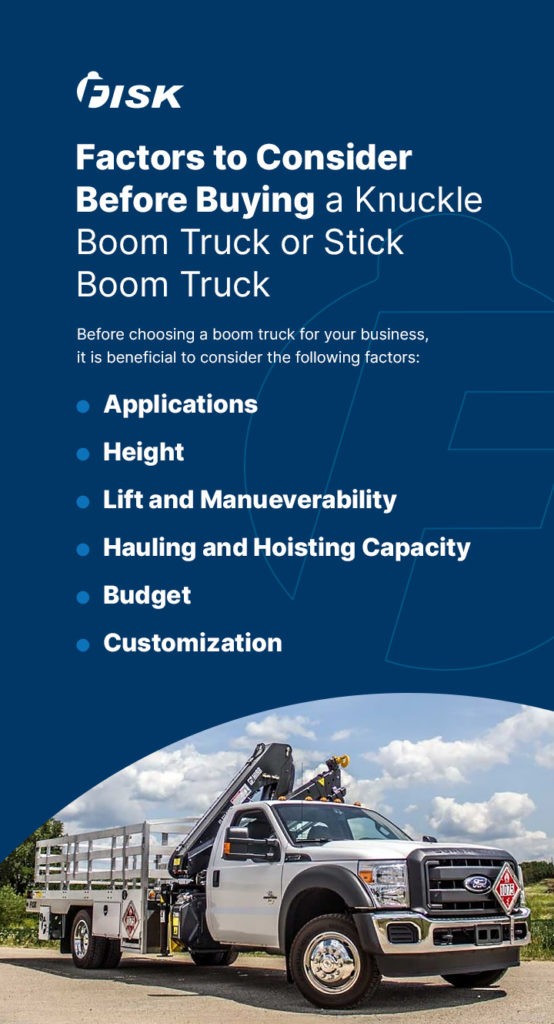
1. Applications
When deciding between a knuckle boom or stick boom truck, it is important to factor in what kind of jobs your business takes on and what services you want to offer in the future. Consider the types of job sites and conditions you work with:
- Straight booms are more suitable for applications such as performing building inspections or painting.
- Articulated booms are best for the applications like electrical or utility work and roofing.
2. Height
Height is a vital factor to consider when choosing between the different types of booms. The kinds of work your business does and the elevation you work at will determine the best option.
Telescopic boom lifts are generally more suitable for applications that require elevated heights. You should also consider the obstacles you will work around when factoring in height. A knuckle boom truck may work best if you need to work around a barrier at elevation.
3. Lift and Manueverability
When deciding on the best type of aerial lift equipment, it is essential to consider the lift direction and maneuverability you will need.
The way the boom moves is one of the most crucial factors to consider. It will determine the type of work you can do and how efficiently your business can complete it.
When looking to access an elevated work site, consider the conditions you often work with. An articulated boom lift is beneficial for applications where operators will need to extend their boom vertically or horizontally and around obstacles. A telescopic lift is often suitable for the job if you work in less complicated conditions and are more concerned with reaching higher heights.
4. Hauling and Hoisting Capacity
Another factor to consider is the capacity for both hoisting and hauling loads with your vehicle. The capacity will be specific to the vehicle and boom you select. It is vital to ensure the boom truck you choose can meet your hauling and hoisting needs safely and efficiently.
5. Budget
It is essential to consider your business’s budget before purchasing any type of boom truck. The total costs of your vehicle will depend on a few different factors, including:
- Maintenance
- Inspection
- Size
- Customization
Generally, a standard articulating boom lift is often slightly more expensive than a telescopic boom lift due to more moving parts and required maintenance.
6. Customization
Before you land on the right boom truck for your business, consider the kinds of customizations that will make your vehicle more suitable for your work. Customizations include:
- Safety and security features
- Branded fenders
- Cone holders
- Air compressors
- Backup cameras
- Side racks
Adding customized options to your boom truck can improve its functionality and help you get the most out of your investment.
Explore Propane Service Trucks From Fisk Tank Carrier
For more than three decades, Fisk Tank Carrier has offered propane tank installation and service trucks for regional and nationwide businesses. We prioritize personalized services and individualized attention to ensure you get the right truck for your needs.
We build custom propane tank service and installation truck options for your business. We’ll work with you to find customized solutions to meet your needs and help your business boost its efficiency and profits.
Are you interested in learning more? Browse our propane service trucks or request a quote from Fisk Tank Carrier today!
